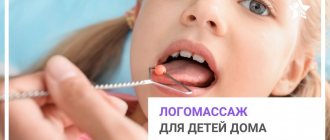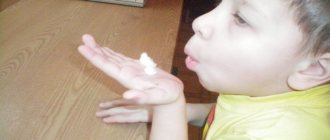Disturbances in the pronunciation of sounds occur in many children. The most common problems are distortion of the sound of a letter (burr, lisp, etc.), its replacement with another, or omission of sounds that are difficult to pronounce. Speech therapy sessions - whether self-guided or under the guidance of a professional - will help eliminate the existing problem.
If speech therapist lessons are not available to you for some reason, then you can work with your child on your own, but following certain recommendations.
Development of a child's speech through games
For preschool children, games for speech development are recognized as the most effective method for eliminating various speech defects.
A game aimed at improving speech abilities not only attracts a child with its fascination, but is also the most useful of all methods for developing this important skill. Speech therapy classes for children, conducted in a playful format, promote speech development, consolidation of new words, and the formation of correct pronunciation of sounds. Additionally, the future foundation for cognitive activity and the development of mental abilities is laid.
Here are examples of the main types of activities aimed at developing the richness of speech in children:
- Addition of the sentence: in summer the leaves on the maple are green, and with the onset of autumn...; We pick mushrooms in ..., and tomatoes in ..., etc.
- Completing the sentence: I want….; I can…; I'll draw... etc.
- Description of the item: pen – new, beautiful, colorful...; chamomile - white, beautiful, summer...; river – deep, wide, transparent...etc.
- Names of domestic and forest animals with young: rooster, hen, chickens; hare, hare, little hares, etc.
- Big - small (the child needs to choose a diminutive for the proposed word): vase - vase, mouse - mouse, leaf - leaf, etc.
- Catch the ball (the speech therapist throws the ball and names a noun, the child’s task is to transform it into an adjective): autumn - autumn, birch - birch, etc.
- Expressing disagreement/agreement (the task of the lesson is to develop in the child the ability to affirm or challenge a proposed thought with the ability to substantiate his opinion): It will start raining soon - No, because there are no clouds in the sky.
- Word formation (in the proposed word you need to replace a specific sound): squirrel - bun, sam - catfish, give - blow.
Try to do the exercises using pictures, children love them very much.
How to organize speech therapy classes at homeTeacher-speech therapist Elena Viktorovna Lantsova
So, you have decided to start teaching your child on your own before you have the opportunity to get qualified help.
Before you begin, prepare everything you might need.
- A large tabletop mirror so that the child can monitor the correctness of his performance of articulation gymnastics exercises. “Lotto” of various topics (zoological, biological, “Cookware”, “Furniture”, etc.).
- It is also good to purchase dummies of fruits, vegetables, sets of small plastic toy animals, insects, vehicles, doll dishes, etc. (or at least pictures)
- Cut pictures from two or more parts.
- Until your child’s speech underdevelopment is completely compensated, your hobby should be collecting various pictures that may be useful in preparing for classes (colorful food packaging, magazines, posters, catalogs, etc.) Get a large box at home where you will put your “collection” "
To develop fine motor skills, purchase or make games yourself: plasticine and other materials for modeling, construction sets, lacing, counting sticks, etc.
- A notebook or album for sticking pictures and planning lessons.
The main difficulty for parents is the child’s reluctance to study. To overcome this, you need to interest the baby. It is important to remember that the main activity of children is play.
All classes must follow the rules of the game!
You can “go on a trip” to the Fairytale Kingdom or visit Dunno. A teddy bear or doll can also “talk” to the baby. It is a rare child who will sit still and absorb knowledge.
Do not worry!
Your efforts will not be in vain, and the results of your studies will definitely appear.
Recommendations from a speech therapist
To achieve results you need to practice every day. The following are held daily:
• games to develop fine motor skills,
• articulation gymnastics (preferably 2 times a day),
• games to develop auditory attention or phonemic awareness,
• games for the formation of lexical and grammatical categories.
The number of games is 2-3 per day, in addition to games for the development of fine motor skills and articulatory gymnastics.
Don't overtire your baby! Don't overload with information! This may cause stuttering.
Start practicing with 3-5 minutes a day, gradually increasing the time. Some classes (for example, on the formation of lexical and grammatical categories) can be carried out on the way home.
The duration of a lesson without a break should not exceed 15–20 minutes.
Later, the child’s attention will dissipate, and he will not be able to perceive any information. Some children cannot concentrate even during this time, because each child is individual. If you see that your child’s gaze is wandering, that he no longer reacts at all to your speech, no matter how hard you try and attract all the play moments familiar to you, then the lesson must be stopped or interrupted for a while.
Introduce your child to children's literature! Try to read at least a few pages to your child, look at the pictures of the text you read, describe them, ask your child questions about the text.
“When can you get everything done?” - you ask. Reading books can be postponed until the evening before bed.
Perhaps other teachers will consider this wrong, because it is at this time in the evening that the child is tired and his attention is scattered. Checked! Reading before bed becomes a child’s favorite pastime - after all, for another 15-20 minutes you can stay awake, chat with parents, and share your secrets.
It is advisable that the theme of the literary work coincide with the lexical theme of the week.
Use visual materials! It is difficult for children to perceive words separated from an image.
For example, if you decide to learn the names of fruits with your child, show them in their natural form or use dummies and pictures.
Speak clearly while facing your child. Let him see the movements of your lips and remember them.
Don't use the word "wrong"! Support all your child’s endeavors, praise even minor successes. Don't ask him to pronounce the word correctly right away. It’s better to just repeat the sample pronunciation of this word yourself.
Don't be afraid to experiment! You can invent games yourself. It all depends on your imagination.
You can adapt (simplify) complex games if the child does not perceive them in the form in which you propose them.
Don't put off until tomorrow what you can do today! Patience and success to you!
Speech therapy classes at home
Speech therapy sessions with a child may include:
- finger games;
- gymnastics to develop articulation;
- games for hearing development, onomatopoeia, logorhythmics;
- recitation of poems and tongue twisters.
You need to work with your child every day, carefully thinking through the course of the lesson, captivating him. If he is not interested, then the baby will not acquire the necessary skills.
When starting speech therapy classes at home, you need to remember the following rules:
- The duration of the lesson must be increased gradually. The first one can last no more than 3 – 5 minutes.
- The activity should be interesting and make the child want to learn. You should not force your baby to do something against his will, otherwise he may refuse to do the exercises altogether.
- You can arrange short classes, but several times a day.
- If a child doesn’t succeed in something, you shouldn’t yell at him. We need to try to find the cause of the “naughty tongue” and correct it.
Finger games
Speech therapy classes for children should include finger games, as they promote the development of fine motor skills. Scientists have long proven a direct connection between the hands and the part of the brain responsible for the development of speech skills.
Learning texts in combination with finger gymnastics helps develop skills such as:
- the ability to think spatially and express one’s emotions;
- imagination;
- attention.
In addition to improved speech, the child experiences an acceleration in reaction speed. Classes conducted in a playful way help to better memorize text and make speech more expressive.
To get the desired result, you need to work with your child every day, spending about 5 minutes on it.
Exercises to develop finger motor skills:
- Flower. Palms are folded together, fingers pointing upward. We form a flower bud from our palms, pressing them together. The child says aloud the quatrain: The sun rises, the flower opens, (fingers need to be spread apart, but the palms remain pressed) the sun sets, the flower goes to bed (fingers need to be returned to their original position).
- Kitty. Palms lie on the table, gathered into a fist. The child says the words “Fist - palm. I walk like a cat” and straightens his fingers, without lifting his palms from the surface of the table, and then squeezes them again. Repeat the exercises three to five times.
- A bird is flying. Hands crossed in front of you, palms facing your face. You need to hook your thumbs together. This will be the “head”, and the palms will act as wings. You need to swing them without separating your fingers. The bird flew (we flap its wings), sat down and turned gray (the child separates his palms and presses them to his chest), then flew on.
Finger games can be used as moments of relaxation during the speech therapy session itself, helping to distract the child and allow him to redirect his attention.
Articulation gymnastics
Before starting speech therapy exercises, it is necessary to conduct an articulatory warm-up. Specialized gymnastics helps strengthen the muscles of the articulatory apparatus and prepare it for speech therapy sessions.
Articulation gymnastics is a set of exercises designed to strengthen the muscles of the lips and tongue. They are responsible for the pronunciation of sounds. If the tongue muscles are not sufficiently developed, speech will sound unclear.
You need to do gymnastics in front of a mirror. Then the child will be able to control the correct execution of the movements. It is very important for him to observe the movements of his lips and tongue. This way the baby will quickly understand what position they should take in order to pronounce sounds correctly.
Articulation exercises should be performed twice a day. The duration of the lesson is 5...7 minutes. As a result, the child will be able to learn to speak not only correctly, but also as clearly and understandably as possible.
Articulatory complex:
- Stretch your lips into a smile, but your teeth should not be visible. Hold the position for 30 seconds.
- Smile widely, opening your teeth. Hold for half a minute.
- Open your mouth slightly and place your relaxed tongue on the surface of your lower lip. Spank them, pronouncing the syllable “PYA”. In this case, the upper lip touches the tongue.
- The mouth is open. You need to stretch your tongue forward and try to curl it into a tube. Hold the position for half a minute.
- Slowly lick your lips with your tongue from corner to corner, without lifting your tongue from the surface of your lips. He must come full circle. First clockwise, then counterclockwise.
- There is a wide smile on his face with his mouth slightly open. The tip of your tongue should touch first one corner, then another.
- A smile on the face with the mouth slightly open. Press the tip of the tongue against the surface of the teeth and, with little effort, move along the back wall of the lower dentition. Repeat 10 times. Repeat the exercise, but you need to pass your tongue along the inner surface of the upper teeth.
- A wide smile on his face. On the count of “one” we touch the lower teeth, on the count of “two” we touch the upper teeth. Repeat the exercises 5 times.
- The mouth is open. Let the child quickly stick out and hide the tip of his tongue. But it should not touch the teeth and tongue.
- A wide smile on his face. The tongue is relaxed and lies on the lower lip. When exhaling air, the child should blow on a ball of cotton wool lying on the table so that it can move.
Games for hearing development, onomatopoeia, logorhythmics
Articulation gymnastics should be supplemented with other exercises. These should be exercises for developing hearing, onomatopoeia and logorhythmics.
Speech hearing helps a child understand, distinguish and reproduce sounds. If it is not well developed, then the baby’s speech is unclear and contains errors.
Examples of exercises to develop speech hearing:
- The child needs to demonstrate objects that can make sounds. These can be spoons, drums, rattles and others. Then you need to let the baby listen to the sound of each. Then he turns his back and guesses which of the objects sounded. The purpose of the exercise is to improve speech hearing and consolidate the skill in distinguishing sounds.
- An adult picks up a bell. The child stands against the wall with his eyes closed. The adult moves around the room and periodically rings the bell. The baby’s task is to point to the sounding bell with his hand without opening his eyes.
The development of onomatopoeia is another part of speech therapy classes. For the exercise, a plot picture is used in accordance with the child’s age group. This could be, for example, an image of a girl rocking a doll. Let the child begin to imitate rocking movements and cradle an imaginary doll. It is important to control its articulation.
Games based on imitating the voices of the animal world give good results. Such speech therapy exercises will be more interesting if images of animals/birds, their figures and figures of babies are used during the lesson.
An example would be the game of mosquito. The picture should show a mosquito. “Let's meet the mosquito. His name is Arseny. He flies a lot and often sings his favorite song - “Z-Z-Z”. Let us also hum it together with Arseny! “Z-Z-Z.”
Then invite your child to catch a mosquito and listen to him sing his song. We grab the empty air with our fists, listen and sing the mosquito song - “Z-Z-Z.”
Logorhythmics are speech therapy exercises that combine movements, music and speech. All children really like these classes because they always take place in a fun atmosphere.
An adult reads the poem aloud and reproduces the movements described in the work. It is very important to select the appropriate musical accompaniment in advance. Then the children repeat what they saw.
For the lesson, you can use, for example, this poem:
Along a narrow path (the child walks in one place) Our legs walked (he begins to take steps in place, raising his knees high) Over pebbles, over pebbles (treads water) And a thump into the hole (the baby jumps and sits on the floor).
Recitation of poems and tongue twisters
Speech therapy sessions with a child should include reading aloud various children's poems. There is no point in teaching complex poems to your child; it is better to start with simple quatrains.
Excellent results can be achieved if speech therapy classes for children include tongue twisters. They are short rhyming sentences. They help make speech clear, well-spoken, and also expand the child’s vocabulary and improve diction.
Six little mice rustle in the reeds. Sasha knocked off some bumps with his hat and got a bruise on his forehead.
You can also come up with your own tongue twister; read about how to do this correctly in the “Speech Development” section on our website.
Independent speech therapy sessions with children will help solve problems with simple defects. If there are serious violations, speech correction should be done by a professional.
Recommendations “How to organize speech therapy classes at home”
Tatyana Chudaeva
Recommendations “How to organize speech therapy classes at home”
These recommendations are addressed to concerned parents who want to help their children overcome speech disorders as quickly as possible. Your child works with a speech therapist in kindergarten 2-3 times a week, depending on the speech diagnosis. Speech correction is a complex and lengthy process that requires significant effort from the speech therapist , the child and the parents. To develop the skill of correct pronunciation of sounds, it is necessary to repeat syllables, words, sentences and texts with these sounds countless times. There is no such opportunity in kindergarten. Therefore, if parents do not consolidate the acquired skills at home , the elimination of deficiencies is delayed, speech disorders become chronic and lead in the future to school failure.
I would like to emphasize that you, parents, are your child's first and most important teachers. His first school - your home - will have a huge impact on what he considers important in life, on the formation of his value system.
No matter how long we live, we still constantly return to the experience of childhood - to life in the family. The emotional attitude towards life and people laid down at this time and the presence or absence of incentives for intellectual development leave an indelible mark on all subsequent behavior and way of thinking of a person. The ability to speak, listen, and use language are also among the things that a child living among people learns very early.
For parents to become good teachers for their children, they must know that the work of correcting deficiencies in the pronunciation of sounds includes three main stages: preparatory exercises; setting (calling)
sound; fixing sound in syllables, words and introducing it into speech.
Preparatory exercises are aimed at developing in the child the correct perception of sound by ear (the ability to distinguish a correctly pronounced sound from an incorrect one, to strengthen and improve the movements of the muscles of the articulatory apparatus (reproducing the correct movements of the tongue, lips, lower jaw, to produce a strong air stream (for example, when pronouncing sound [p], you need to be able to blow air strongly onto the tip of your tongue to bring it into a vibrating state).
The better the preparatory work is done, the faster the child will learn to pronounce sounds correctly. It is difficult to say how much time will be needed for the preparatory exercises. In some cases - three lessons , in others - several weeks. This depends on the degree of impairment of the mobility of the muscles of the articulatory apparatus, on the state of speech hearing, as well as on the individual characteristics of the child.
Staging (calling)
sound is the task
of a speech therapist . But sometimes, with a simple violation, parents succeed. In order to evoke the correct sound in a child, it is necessary to carefully study the position organs during normal pronunciation of the sound and the methods of producing it. To do this, sit at the table, place a mirror in front of you and, while pronouncing the most difficult sounds (hissing, whistling, sonorous, carefully look at the position of your lips, teeth, tongue. Remember this position. This is important for correcting the defect, for producing the sound. Then sit the child in front of the mirror and ask him to pronounce this or that sound. Take a closer look at what position his speech organs , compare with the position and movement of the speech organs in your own . Now the main task is to achieve the correct isolated pronunciation of the sound. If you can cause sound by imitation, then, bypassing the preparatory stage, you can immediately begin to consolidate the sound in words and speech. If the sound does not work, do not be zealous, otherwise you can only consolidate the incorrect pronunciation. Perform the preparatory exercises, and the speech therapist .
Sound reinforcement and introduction it into speech.When fixing a sound, it is necessary to follow a certain sequence. First, the sound is fixed in syllables, then in words, and only then in phrases.
Let us dwell in more detail on the first stage of work to correct deficiencies in the pronunciation of sounds.
Even the most careful work of a kindergarten does not exclude the need to help children who incorrectly pronounce one or another group of sounds in the family.
By performing certain targeted exercises at home a speech therapist , parents help prepare the child’s articulatory apparatus to correctly pronounce those sounds that he does not pronounce well.
An important role in the formation of the pronunciation of sounds is played by the clear, precise, coordinated work of the articulatory apparatus (lips, tongue, lower jaw, soft palate)
.
To develop full movements of the lips, tongue, and jaw, as already mentioned, articulatory gymnastics is useful.
Various exercises help:
• production of a targeted air stream;
• relaxation of the tongue muscles;
• the ability to hold the tongue in a calm, relaxed position;
• strengthening the muscles of the tongue;
• lifting the tongue muscles upward;
• development of raising the back of the tongue upward, etc.
You need to do articulation gymnastics with your child for a few minutes every day.
Articulation gymnastics is performed standing or sitting in front of a mirror.
The pace and number of exercises gradually increases. These exercises are performed with counting, clapping, and music.
When working at home with children , parents should remember:
1. You cannot force a child. Classes will be effective if they are conducted in the form of a game.
2. You should move on to subsequent exercises only after mastering the previous ones.
3. All exercises must be performed naturally, without coercion.
4. Some exercises are performed using a count kept by adults. This is necessary so that the child develops the most important stability of the positions of the lips and tongue.
5. When carrying out exercises, the child may not always succeed in everything, and this sometimes causes refusal to further work. In this case, parents should not fixate the child on the fact that he can’t do it; they need to encourage the child, return to a simpler exercise, pointing out that it didn’t work out before, but now he has already learned.
6. For all questions that arise, be sure to consult with a speech therapist or teacher.
Classes should be held in a playful way, because this is the main activity of children. You can use your favorite toy: “let’s show the bunny how to properly perform gymnastics for the tongue.”
It is best to carry out articulatory gymnastics in the form of a fairy tale, based on a picture-image.
THE TALE OF THE Merry Tongue
(a set of exercises that develops the correct articulatory structure of the sounds SH-ZH-SHCH.)
Once upon a time there was a Merry Tongue. He had a house. This is the mouth. To prevent Merry Tongue from running out, his house was always closed. There are two doors in the house.
The first door is the lips. Let's open it (exercise "Frogs"
).
The second door is teeth. Let’s open it too (exercise “Window”
)
What does our Tongue do? He's sleeping. It has a soft pillow - your lip (exercise “Spatula”
)
Look how sweetly and calmly the tongue sleeps (hold your tongue on your lower lip for a while)
.
Finally he woke up, smiled (exercise “Smile”
, took the trumpet and played
“Tut-tu, I woke up!”
(exercise
“Pipe”
).
Tongue went to the kitchen, and there mom was kneading the dough “Five-five”
(exercise
“Knead the dough”
) and bakes pancakes (exercise
“Pancake”
).
Tongue took a cup of tea (exercise “Cup”
, jam, bagels (exercise
“Bagel”
) and began to have breakfast. But he didn’t eat carefully and stained his upper lip with jam (exercise
“Tasty Jam”
). After eating, Tongue decided to show his mother the real one. focus (exercise
"Focus"
).
Tongue wanted to take a walk. He went out into the yard and saw a swing. I decided to go for a ride (exercise “Swing”
).
Then our tongue saw a horse and he wanted to ride it. It was fun for him to ride a horse (exercise “Horse”
)
Tongue had a walk and went home. First he closed the second door - his teeth, and then the first - his lips (close his lips)
.
The ability to focus on sound is a very important human characteristic. Without it, it is impossible to learn to listen and understand speech - the main means of communication. It is also important to distinguish, analyze and differentiate by ear phonemes (the sounds that make up our speech)
. This skill is called phonemic awareness.
A small child does not know how to control his hearing and cannot compare sounds. But a child can be taught this. It is especially necessary to develop auditory attention and phonemic hearing for children with speech problems. Sometimes a child simply does not notice that he is pronouncing sounds incorrectly.
The purpose of our exercises is to teach the child to listen and hear. You will soon notice that the child has begun to hear himself, his speech, that he is trying to find the correct articulation of sound and correct defective pronunciation.
The goal of all these games is to develop auditory attention (concentration, stability, switching)
.
Games for the development of phonemic awareness are recommended for children over 3 years of age. Good phonemic hearing is necessary for a child to master the sound system of the language and for competent oral and written speech.
From the cradle, a baby is taught to respond to intonation, rhythm and sound of words. Already at the end of the first year of life, the child notices differences in the sound of words. He begins to distinguish some speech sounds from others, and tries to pronounce them correctly. By the end of the second year, he distinguishes all the sounds of his native language and can notice defective pronunciation of sounds in the words of his peers, and tries to correct them. The phonemic distinction of sounds becomes available to him. Every child makes this journey in mastering the sound side of a word. To compensate for the delay in the child’s speech development, this path should not be carried out spontaneously. An adult must come to the child’s aid in a timely manner and purposefully guide the development of his speech activity. All this is necessary for a child without deviations in speech development, because a conscious attitude towards language is the basis for mastering all aspects of the language (phonetic, lexical, grammatical)
and forms of speech
(dialogical and monological)
.
The recommended exercises help the child master the sound system of his native language and prepare the child for mastering literacy and written speech.
1. Game for distinguishing non-speech sounds, developing auditory attention and auditory memory “Guess what it sounds like”
.
Equipment: screen, various toys and objects that can be used to produce characteristic sounds: bell, tambourine, drum, paper, foil, pipe, rattle, rattle, etc.
Move. An adult behind a screen rings a tambourine, rustles paper, rings a bell, etc. and invites the child to guess what object produced the sound. The sounds must be clear and contrasting so that the child can guess them. Instead of a screen, you can invite the child to simply sit with his back to the adult.
2. A game to distinguish identical words, sound complexes and sounds, focusing on the height, strength and timbre of the voice “Guess who is screaming”
Equipment: toys or pictures depicting domestic animals : cow, dog, cat, horse, etc.
Move. The adult shows the child prepared pictures or toys and plays with them, imitating the cry of the corresponding animals. Then he asks the child to listen and guess who will come to visit them. An adult covers his mouth with a piece of paper and makes a voice, imitating one of the animals. The child guesses who it is. The game can be repeated 5-6 times. It is necessary to ensure that the baby listens carefully and activate him with questions.
3. Word recognition game “Magic Wand”
Equipment: an item that can act as a magic wand (laser pointer, pencil wrapped in foil, etc.)
.
Move. An adult and a child examine objects in the room. An adult has a magic wand in his hand, with which he touches an object and names it loudly. Following this, the child pronounces the name of the object, trying to make it as clear as possible. The adult constantly draws the child’s attention to the fact that they are pronouncing words. It is necessary to ensure that the child correctly correlates words with objects.
A child's mind is at his fingertips. (V. A. Sukhomlinsky)
Research by scientists from the Institute of Physiology of Children and Adolescents of the Academy of Sciences (M. M. Koltsova, E. A. Isenina, L. V. Antakova-Fomina)
the connection between intellectual development and finger motor skills was confirmed. The level of development of children is also directly dependent on the degree of formation of fine hand movements. To determine the level of speech development of children in the first years of life, the following method has been developed: the child is asked to show one finger, two and three. Children who are able to make isolated finger movements are talking children. If the movements are tense, the fingers bend and straighten only together and cannot move in isolation, then these are not speaking children.
Speech and motor zones are located next to each other, so “by irritating one, the other is improved”
Since there is a close relationship and interdependence of speech and motor activity, if a child has a speech defect, special attention must be paid to training his fingers.
You can train your fingers as early as 6 months of age. The simplest method is massage: stroking the fingers in the direction from the fingertips to the wrist.
The hedgehog stomped along the path
And he carried mushrooms in a basket.
To count the mushrooms,
You need to bend your fingers.
Children bend their fingers one by one, doing a massage, first on the left, then on the right hand. At the end of the exercise, the child’s hands should be clenched into fists.
I wish you success in your studies and joy in communication!









